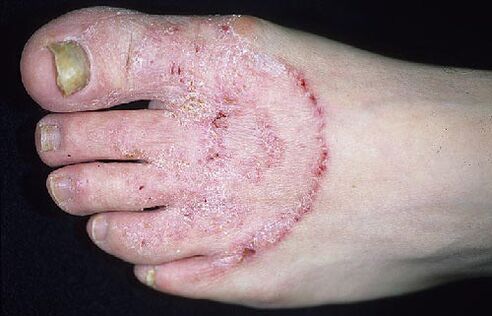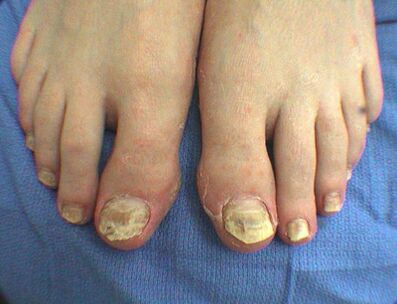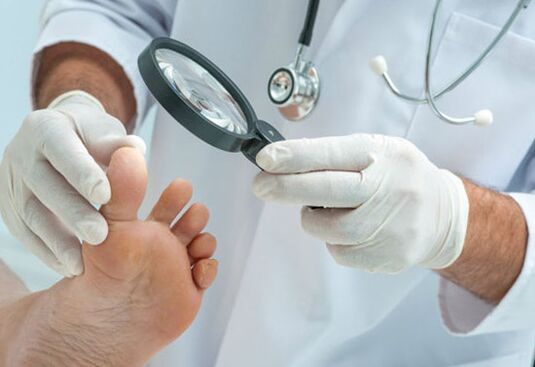The nail fungus (onocytia) is the most common disease in which the nails become yellow, become fragile and thick, covered with cracks.In the early stages, the symptoms of nail mussels are slightly remarkable.The treatment of the disease is difficult due to weakened cellular immunity.The disease progresses slowly, without proceeding with the right treatment and can accompany the patient all his life.

Most often, nail fungus is detected in a man and people with weakened immunity.Patients with diabetes, obesity, treat blood vessel pathology and skin diseases are subject to diseases.With high sweat legs, there are more chance of fungal damage to the skin of the feet and nails on the legs.
The fungus can take on the nail plates from clothes, shoes, manicure sets, carpets, flooring.It enters the nails via skin microcrescion and through the nail bed.It is very much where it is warm and wet: in souls, baths, changing rooms and swimming pools.In healthy people, the disease rarely develops.
The cause of the disease
Onychomycosis is caused by three types of fungi (one by one or in combination).Most cases of the disease are caused by Rubrum trichophyton mushrooms.Much less often - Trichophyton interdigitale, epidermophyton floccosum and microsporum and Aspergillus.
- Candida albicans dough fungi are always parasitized on the skin and nails.Taking antibiotics, contraceptives and immunity reduction can develop dough infection.
- Mold fungi often cause diseases in countries with a tropical climate.
- Soil fungi live on the ground and cause only a few people.From person to person are not transmitted.
Which is the source of infection
- Diseases in family and friends can become a source of pathogens for you.
The fungus is transmitted to the family through use with a common towel, slippers, bedding, etc. - The fungus in the hands can become a source of nail disease and skin skin.
- In large numbers, the fungus lives in bathrooms, shower and swimming pools.
- The source of the infection can be patient's clothes and shoes, manicure sets, carpets and floors.
That increases the risk of the disease
- The fungus of the skin of the legs.
- Reduction of immunity.
- Members of the family suffering from fungus defeat.
- Elderly age.
- Diabetes.
- The presence of microtramids and Burrs.
- Increased sweating of the legs.
- Unknown and poor quality shoes.
- The habit of walking barefoot in public places.
- Accommodation and work in a wet climate.
- In the long run wearing artificial nails.
Affecting the growth and evolution of nicheomy
- General health.
- Sensitivity to infection.
- The level of humidity and thermal background.
- The type of nail plate (fingers on the fingers grow slower).

Symptoms of nail fungus
At the beginning of the disease, the usual nail color changes.Becomes opaque.A gap in which the fungi itself appears between him and his bed.
The nail is painted in one of the colors: white-gray, yellow, green and brown, to black.Yellow elongated strips in the nail and below it are visible.Signs of different shades.
The nail thickens and deforms over the affected area.The masses of the horn are gradually developing, preventing drug penetration.
Initially, there is also increased intelligence, when the fungus affects the entire nail plate, it begins to collapse and collapses.During treatment, a large amount of "rubbish" is formed that consists of destructive fragments and skin.There is often damage to the skin around.
Forms
- Remote submarine ebliomysis.
- Lateral onychomycosis.
- White surface of onocycosis.
- The volume of the near disk.
- Total dystrophic onocystiasis.
Remote submarine and lateral onychomycosis
This form of the disease is the most common.Up to 90% of cases, its cause is the mushrooms of the genus Trichophyton Rubrum.Infection of the nail plate begins on the free edge of the affected foot skin.First, the nail bed touches.The type of damage resembles a slate or yellowish color.With the progression of the disease, the nail thickens and can be separated or separated from the skin.Remote submarine on -one -omycosis is difficult to cure.Wearing shoes causes discomfort.
White surface
The second most common form of onychomycia.In 90% of cases, the disease is caused by the genus of the genus Trichophyton interdigitale, which only affects the upper layer of the nail plate, which never thickens and is separated from the skin.Over time, its entire surface becomes relaxed, such as chalk dust.Treatment occurs quickly.
Ooze
This form of onychomycosis is rare.Red hair in blood and lymphatic trails spread throughout the body.This is evidenced by the nail damage from the back (proximal) and the detection of the pathogen in the lymph nodes of the groin and prostate secretion.The disease is often recorded in HIV infected.The defeat begins with the skin in the area of the nail fold, which thickens.In addition, the nail plate is involved in the process, which acquires a white opaque color.
Total dystrophic nail
This form of the disease is a consequence of the progression of one or a set of types of the above forms of onychomycia.Nail plate is partially or completely destroyed.
Diseases with similar symptoms

Of all infectious diseases, onychomycia is in 50% of cases.Similar symptoms are found in the following diseases:
- Eczema.
- Psoriasis.
- Reuters syndrome.
- Daria disease.
- Flat lichen.
- Norwegian scabies.
Diagnosis of nail fungus
In order to get information about what has caused some changes, you should consult a dermatologist who organizes the process of diagnosing the disease.The scraping of the affected part will be sent to the laboratory to clarify the causes of the disease.
Microscopy will determine the presence of a fungus and sowing in a nutritional medium will highlight the pure culture of the pathogen and determine the sensitivity to antifungal drugs.
Before starting treatment, it is necessary to determine the type of infection. The nail fungus on the legs is easier to warn.Consider legs and nails on your feet more often.The timely principle of treatment will help rapidly improve, reduce the sense of discomfort and eliminate cosmetic effect.

























